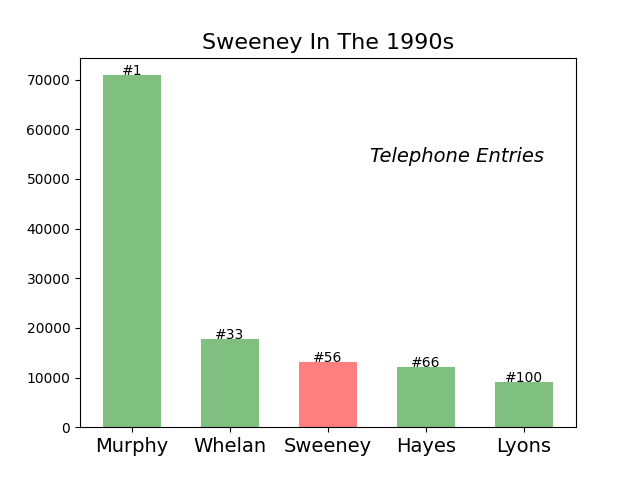This article looks at how common Sweeney is as a last name in Ireland and the United States from the 19th century to the present day.
You’ll learn the meaning and origins of the Sweeney surname while exploring some notable and famous people that held it.
I use census records, emigration lists, and military archives to uncover fascinating patterns. If you’re studying your genealogy, check out my sources at the end of the post so you can do your own research.
How Common Is Sweeney As A Surname In Ireland?
Detailed current statistics about surnames are not publicly released by the Irish government. Instead, they offer the ten most frequently occurring surnames among newborns in the previous year. Sweeney
However, an Irish genealogist studied the top one hundred surname numbers in Ireland between 1992 and 1997. Seán Murphy based his research on telephone books. This isn’t as accurate as a census but gives a good approximation.
Sweeney was ranked 56 in the top one hundred names in this decade with a total of 13,200 entries.
This graphic shows how it ranks compared to the 1st, 33rd, 66th, and 100th entries in the survey:

Sweeney In The Early 1900s
The only full censuses that are publically available in Ireland are from 1911 and 1901. Prior decades were either destroyed through government action (to reclaim storage space) or by a catastrophic fire during the Irish Civil War.
So, let’s focus on the early 1900s.
I used online archives to calculate the total numbers by surname. I consider these estimates due to some percentage of transcription errors. So, I’ve rounded the numbers to the nearest fifty.
There were 8,850 residents named Sweeney on the island in 1911.
Ten years earlier, Sweeney had about 9,100 residents in the 1901 census.
Population Estimates In The 1890s
A study of Irish surnames was conducted in 1890 by the head of the Civil Registrations Office. It was published as a “Special Report on Surnames In Ireland.”
The survey estimated that there were about 12,500 people named Sweeney in the country.
Emigration To America After The Irish Famine
The Irish have historically emigrated to Britain, the United States, Canada, and Australia. They were motivated by multiple factors, including social unrest, economic desperation, and hunger.
The largest wave of emigration to the United States occurred during the 19th century. The peak was in response to the Great Irish Famine, which took place between 1845 and 1852. A plant disease devastated the main food and income crop for much of the population.
I reviewed the Sweeney name in the shipping passenger lists arriving in New York during this period. The departures were from both Ireland and England.
This picture shows how the numbers rose and fell in the years after the famine:

How Common Is Sweeney As A Last Name In The U.S.?
Based on the 2010 U.S. census, the name Sweeney ranks about 651 among Irish names in America with 52,410 bearers.
Although the 2010 census has exact numbers and rankings, the rank I assign here is my estimate. If you’re curious about how I got there, here’s a brief explanation…
Estimating Rank In The United States
Historically, some Irish families with Gaelic surnames took English-sounding names as translations under the influence of colonization.
As these names also have English origins, they will have been brought to the United States by both British and Irish immigrants. Because the census doesn’t ask about specific European origin (e.g. England vs Ireland), it’s impossible to identify the proportion with Irish heritage.
I reviewed the census to identify which names are predominantly Irish in origin. In order to estimate the relative rankings of “Irish” names, I’ve mostly excluded surnames that have varying origins.
Sweeney In Historic Times
In a country as young as the United States, tracking the popularity of a surname over time can be fascinating. This reflects other demographic shifts across the country in addition to immigration. Higher child mortality rates and longer life expectancy are just two factors.
The historic census records have been transcribed and digitized. I used online archives to run counts of surname populations.
But the totals can’t be exactly accurate due to transcription errors. So, I’ve rounded the numbers to the nearest 50 in the graph below.
This picture shows the numbers every twenty years from 1860 to 1940:

These are the numbers in the graph:
- 1860: 5,200
- 1880: 12,800
- 1900: 20,900
- 1920: 26,100
- 1940: 31,500
Sweeney In World War II
During World War Two, approximately 8.3 million men and women joined the ranks of the United States Army. Many were of Irish descent. Some had even been born in Ireland and emigrated.
There were registration records for 2,077 soldiers named Sweeney who enlisted between 1938 and 1946.
There were 32 who were born in Ireland.
Sweeney Surname: Meaning And Origin
Sweeney comes from the Gaelic name Mac Suibhne. The term “Mac” means “son of” in Irish, so the name literally means “son of Suibhne”.
The personal name Suibhne derives from the Gaelic words for pleasant or sweet. So, the full name is akin to “son of the pleasant person”.
An early prominent family in the 13th century settled in Donegal where they were the personal troops (gallowglasses) of the O’Donnell chiefs. The Sweeney families spread out as far south as Muskerry in County Cork, where they were allied to the MacCarthys.
Famous Or Historic People Named Sweeney
Here are some notable people with the family name:
- Frances Sweeney (1908 – 1944): Boston journalist who campaigned vigorously against fascism and anti-semitism within Catholic circles and the Boston police force.
- Asher William Sweeney (1920 – 2003): achieved the rank of Colonel in the U.S. Army before being elected to the Ohio Supreme Court in 1976 where he served for eighteen years.
Sources

External Research
The Ireland 1990s estimates are from Seán J. Murphy’s research paper.
The population estimates of 1890 are based on the “Special Report on Surnames in Ireland“, published in 1909.
The population figures for the 2010 U.S. Census come from a file provided by the U.S. Census Bureau.
Internal Research
Some of the population numbers are based on my own research and calculations using online archives. I’ve rounded those numbers to the nearest 50 to account for transcription errors and other technical issues with online databases of this type.
The Irish census estimates for 1901 and 1911 are my calculations based on the Irish National Archives
I plotted the emigration figures from 1845 to 1854 based on calculations from the archives of the New York Passenger Lists (1820-1957).